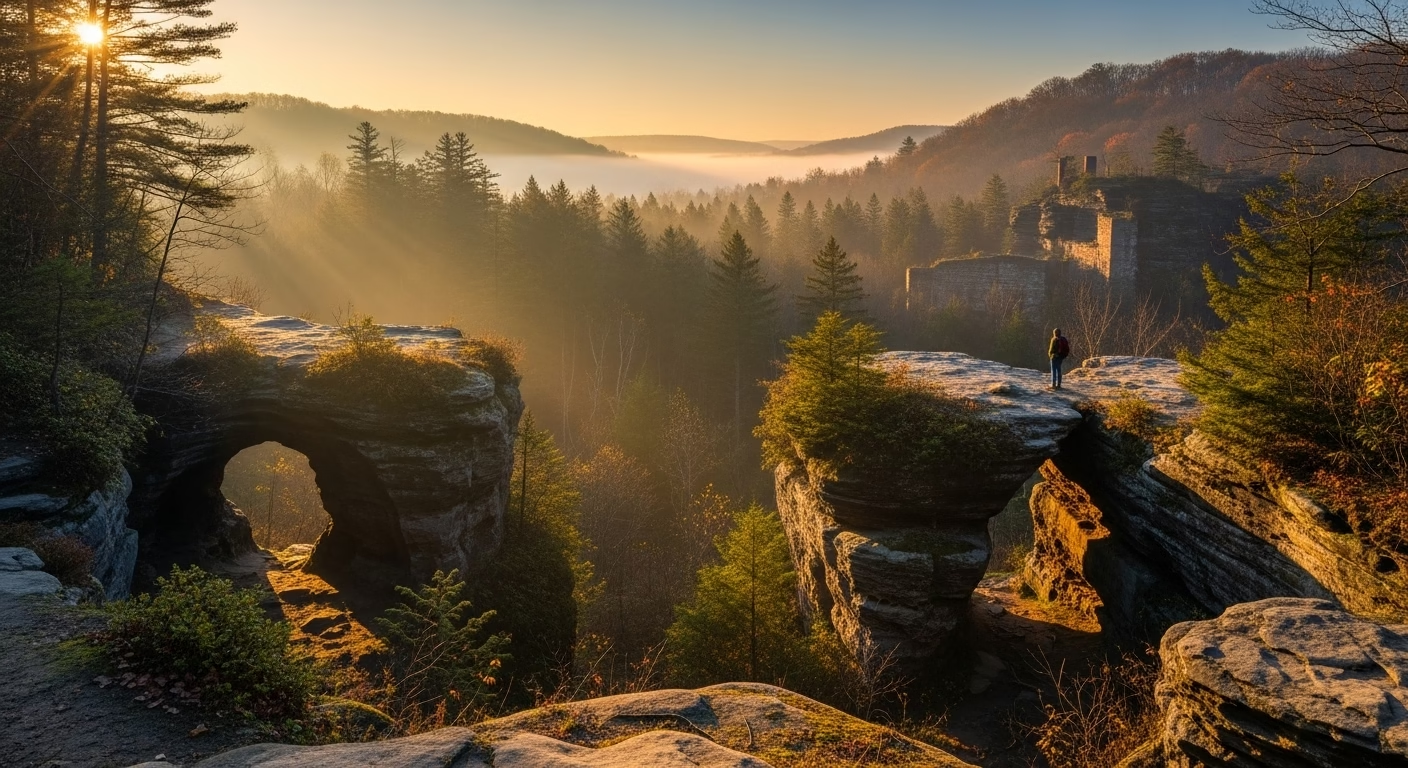
Best Hidden Gems in Pennsylvania: Complete Local’s Guide
Listen, I’ve been wandering around this planet for over two decades, and I can tell you something that might surprise you: some of the most jaw-dropping places I’ve ever discovered aren’t in exotic foreign countries or famous national parks. They’re hiding right here in Pennsylvania, tucked away in corners that most people drive right past without a second glance.
After spending countless weekends exploring every nook and cranny of the Keystone State, I’ve stumbled upon places that honestly made me question everything I thought I knew about Pennsylvania. We’re talking about ghost towns where nature is slowly reclaiming civilization, ancient rock formations that predate human history, and engineering marvels that have been forgotten by time.
The thing is, these hidden gems aren’t your typical tourist traps. They require a bit of effort, some proper preparation, and honestly, a healthy respect for both nature and history. But trust me, the payoff is absolutely worth it. These are the kinds of places that will give you stories to tell for years and photos that’ll make your friends question whether you’ve been secretly traveling to some undiscovered country.
If you’re planning to explore more destinations across America, you might also want to check out our comprehensive guide to 15 breathtaking places to visit in the USA this summer for even more adventure inspiration beyond Pennsylvania.
Abandoned Places in Pennsylvania Worth Exploring
Wehrum Ghost Town: Coal Mining History
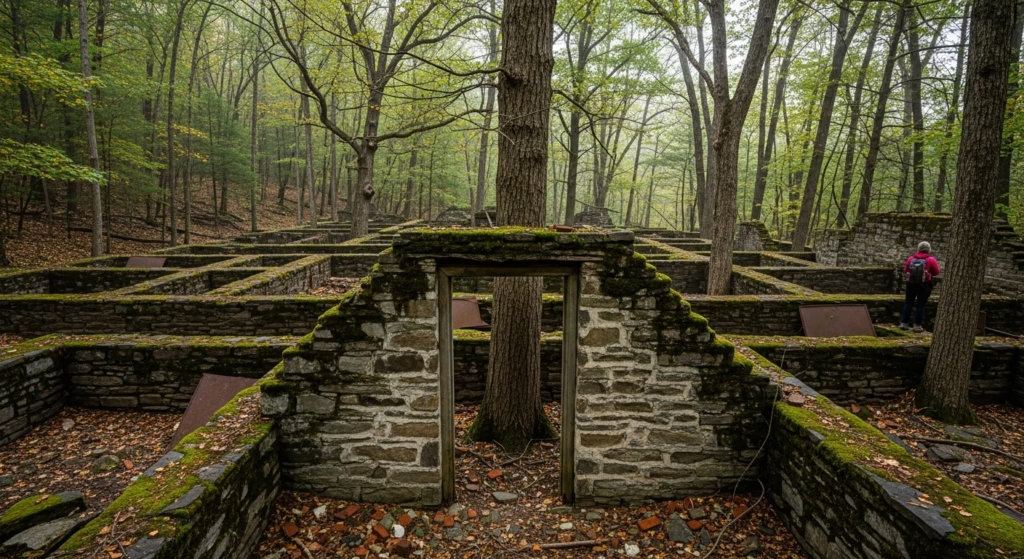
I’ll never forget the first time I stumbled upon Wehrum. I was following what I thought was just another hiking trail when suddenly, I found myself walking through what felt like a post-apocalyptic movie set. This place was a booming coal mining town back in 1901, complete with company houses, a school, and all the infrastructure needed to support hundreds of families.
What makes Wehrum absolutely fascinating is how nature has completely taken over. You’ll find massive trees growing straight through the middle of building foundations, their roots creating these incredible natural sculptures as they break apart the old stone walls. It’s both beautiful and haunting as hell.
The Ghost Town Trail that leads you here is actually built on the old railroad bed that once carried coal out of these mountains. Walking along it, you can almost hear the echoes of the past – the sound of pickaxes, the rumble of coal cars, and the voices of families who called this remote place home.
Safety tip: Bring sturdy hiking boots and watch your step. Some of these foundations have deep holes that are now hidden by vegetation. Also, respect the site – this is essentially a cemetery of dreams and hard work.
Austin Dam Ruins: Pennsylvania Engineering Disaster Memorial
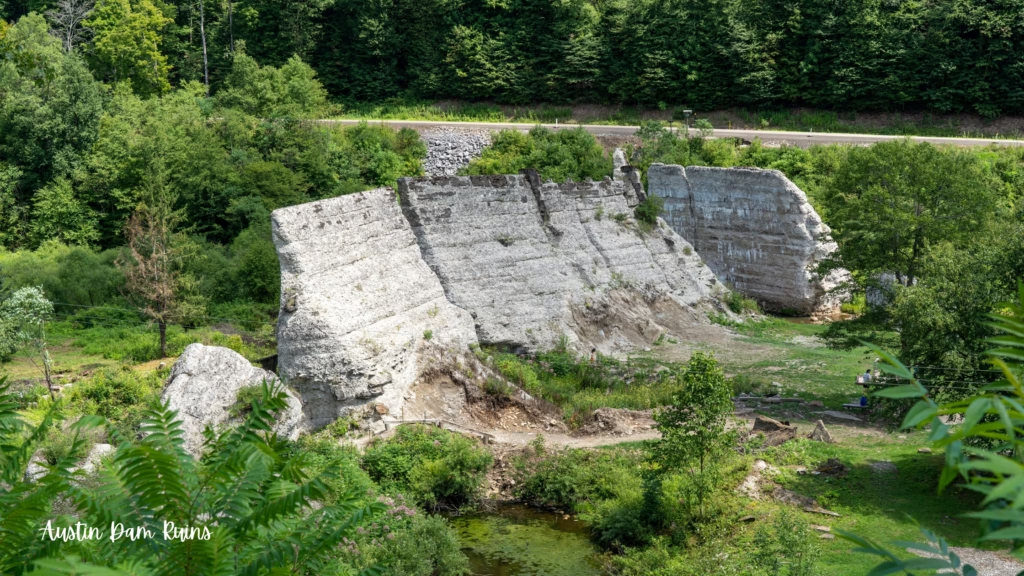
This one hits different, folks. The Austin Dam wasn’t just any old dam – it was supposed to be Pennsylvania’s engineering marvel, the largest concrete gravity dam of its type in the state when it was built in 1909. Famous last words, right? On September 30, 1911, this 50-foot-high, 540-foot-long structure catastrophically failed, killing 78 people and wiping out everything in Freeman Run Valley in a matter of minutes.
Standing in front of these massive concrete ruins today in Potter County, you can’t help but feel the weight of that tragedy. The chunks of concrete are absolutely enormous – we’re talking pieces from a structure that once held 200 million gallons of water, just scattered around like a giant’s building blocks. It’s a sobering reminder of how quickly human ambition can turn into human tragedy.
After a full day of hiking around the incredible dam ruins, you’ll definitely need a comfortable place to kick up your feet and look through your photos. Whether you’re picturing a cozy local inn or a convenient motel to use as your basecamp, this is the perfect place on Hotels.com to start your search for lodging in the Potter County area.
The Austin Dam Memorial Park does an excellent job of honoring the victims while allowing visitors to explore and understand what happened. There are hiking trails that lead you right up to the ruins, and the interpretive signs tell the story in a way that’s both educational and respectful. The site was added to the National Register of Historic Places in 1987, ensuring its preservation for future generations.
For more information about visiting this site, check the Pennsylvania Department of Conservation and Natural Resources website for current trail conditions and access information.
Abandoned Pennsylvania Turnpike: Ghost Highway Experience
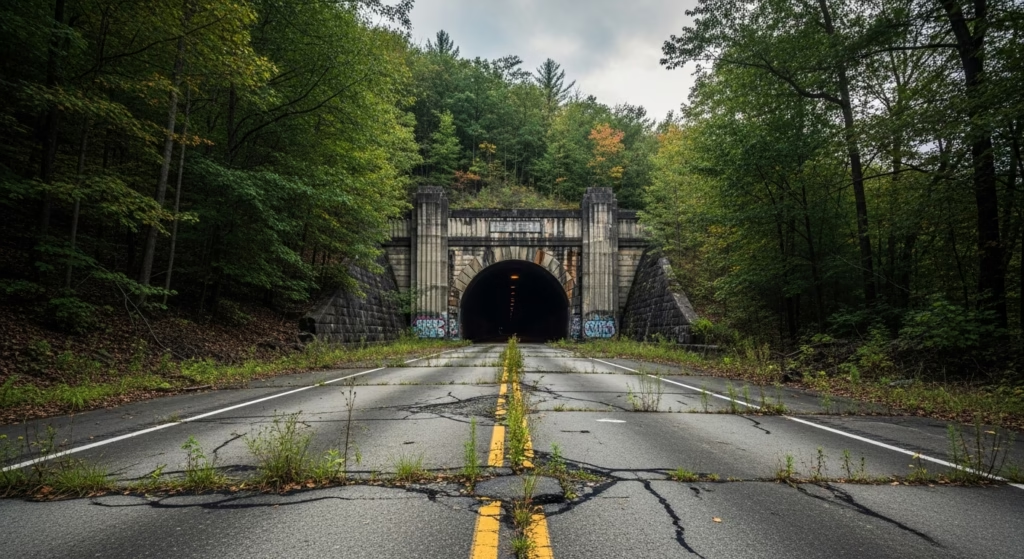
Okay, this is probably one of the coolest damn things I’ve ever explored in Pennsylvania. Picture this: a 13-mile stretch of perfectly good highway that was just… abandoned. Not destroyed, not demolished – just left to sit there like some kind of automotive purgatory when the Pennsylvania Turnpike Commission built the new route in 1968.
The story behind it is actually pretty fascinating. This section between Breezewood and Bedford was part of America’s first superhighway when it opened in 1940, but the two tunnels – Ray’s Hill Tunnel (3,532 feet) and Sideling Hill Tunnel (6,782 feet) – created bottlenecks that couldn’t handle increasing traffic. So they just built a new route and walked away from the old one.
Ray’s Hill Tunnel is the real star of the show here. Walking through this thing is like stepping into a post-apocalyptic movie. The echo of your footsteps, the way light filters in from both ends, the graffiti that’s accumulated over the decades – it’s simultaneously creepy and beautiful. The tunnel’s Art Deco-influenced concrete portal is a testament to the ambitious engineering of the original Pennsylvania Turnpike.
Pro tip: Bring a flashlight even during the day. The middle of that tunnel gets dark as hell, and you don’t want to trip over the debris that’s accumulated over the years. Also, this is now part of the Pike2Bike trail system, so you might encounter cyclists enjoying this unique piece of American transportation history.
If you’re interested in exploring more unique destinations across the USA, our guide to small town summer escapes features other off-the-beaten-path American adventures.
Natural Hidden Gems Pennsylvania: Secret Swimming Holes and Rock Formations
Bilger’s Rocks: Pennsylvania’s Secret Rock City
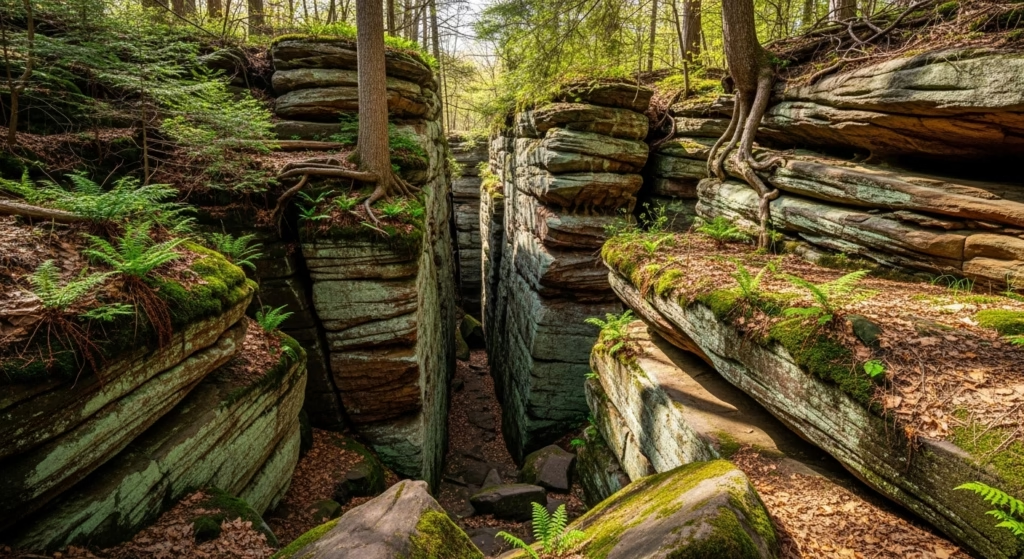
Holy shit, this place is like nature’s own jungle gym for adults. Bilger’s Rocks in Bloom Township, Clearfield County, is basically a massive playground made of 316-million-year-old Homewood Formation sandstone that’s been carved and shaped by time into this incredible maze of caves, tunnels, and climbing opportunities across 20 acres of geological wonder.
The first time I visited, I honestly got lost for about an hour. And I’m not talking “oh, I took a wrong turn” lost – I mean completely turned around in this labyrinth of Carboniferous Period rock formations, crawling through passages and popping out in completely unexpected places. It’s like being inside a three-dimensional puzzle that Mother Nature spent 316 million years perfecting.
| Bilger’s Rocks Quick Facts | Details |
|---|---|
| Age of Formation | 316 million years old (Carboniferous Period) |
| Rock Type | Homewood Formation Sandstone |
| Park Size | 20 acres |
| Maximum Height | 50 feet |
| Best Time to Visit | Spring through Fall |
| Difficulty Level | Moderate (requires scrambling) |
| Parking | Free roadside parking on Bilger’s Rocks Road |
| Facilities | None (bring your own water) |
What makes this place so special is that it’s not just about looking at pretty rocks – you’re actively exploring and navigating through them. Some passages are tight squeezes that’ll have you questioning your life choices, while others open up into cathedral-like chambers that’ll take your breath away. The differential weathering of the sandstone layers has created this natural architecture that’s both challenging and beautiful.
For those who enjoy outdoor adventures like this, you might also be interested in our guide to best US mountain getaways for summer which features more incredible natural formations and hiking opportunities.
Seven Tubs Natural Area: Pennsylvania Natural Swimming Holes
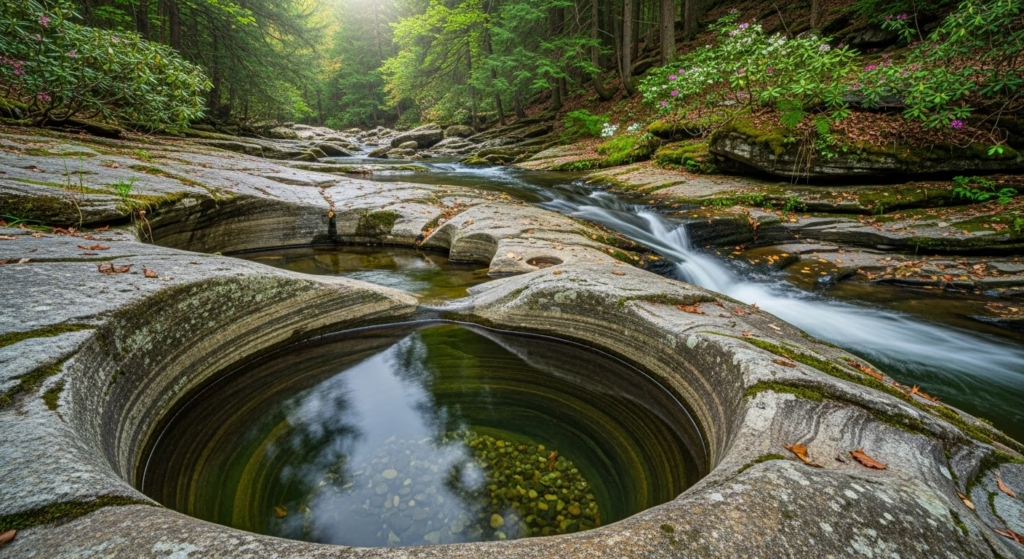
Nature basically built Pennsylvania its own water park about 12,000-15,000 years ago during the Wisconsin Glaciation, and most people still don’t know it exists. Seven Tubs Natural Area in Bear Creek Township, Luzerne County, features these incredible glacial potholes – basically natural swimming pools carved into the Llewellyn Formation bedrock by swirling glacial meltwater along Bear Creek.
The water here is absolutely pristine – so clear you can see every detail of the Devonian-age rock bottom even in the deeper pools. On a hot summer day, slipping into one of these natural tubs fed by Bear Creek is like finding paradise. The water stays cool even in the heat of summer, and the smooth rock surfaces polished by thousands of years of glacial action feel amazing under your feet.
| Seven Tubs Visitor Guide | Information |
|---|---|
| Best Swimming Season | June through September |
| Water Temperature | 60-70°F in summer |
| Depth Range | 2-8 feet in main pools |
| Hiking Difficulty | Easy (0.5 mile trail from parking) |
| Natural Area Size | 339 acres |
| Managed By | Pennsylvania Game Commission |
| Parking | Small lot on Bear Creek Road, arrive early |
| Facilities | Restrooms, picnic tables |
The easy hiking trail makes this accessible for families, but here’s the thing – it’s not exactly a secret anymore among locals. If you want to enjoy it without crowds, get there early in the morning or visit on weekdays. Trust me, having one of these glacial pools to yourself is an experience you won’t forget.
For current conditions and regulations, check the Pennsylvania Game Commission website before visiting, as rules can change seasonally to protect wildlife.
Hammersley Wild Area: Pennsylvania Old Growth Forest
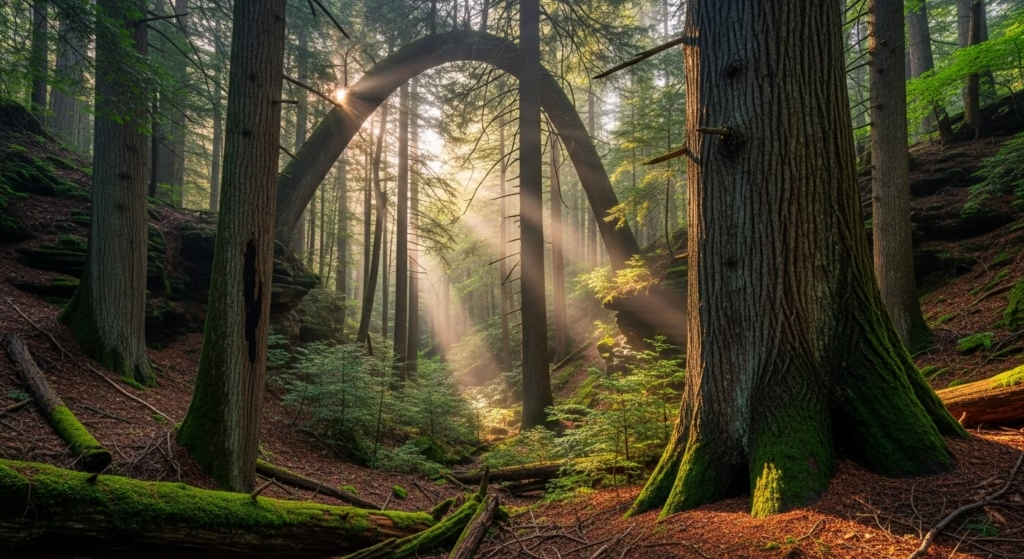
If you want to experience what Pennsylvania looked like before European settlement, Hammersley Wild Area in Potter County is your time machine. This 30,253-acre preserve within the Susquehannock State Forest is the state’s largest roadless area, and when I say roadless, I mean it – no cars, no development, just pure, untouched wilderness at elevations reaching over 2,000 feet.
The old-growth Eastern Hemlock groves here are absolutely mind-blowing. We’re talking about trees that were already ancient when the first European settlers arrived in Pennsylvania. Some of these hemlocks are over 500 years old, with trunks 3-4 feet in diameter, and tower more than 100 feet above the forest floor. Standing among them is like being in a natural cathedral – there’s this hushed, reverent quality to the place that makes you want to whisper.
- Included raincover made with PFAS-free DWR and bluesign approved materials
- Curved zip access on one side of panel
- Floating top lid with lash points
The Susquehannock Trail System runs through here, offering some of the most challenging and rewarding backpacking in Pennsylvania. The 85-mile loop trail passes through multiple ecosystems, from old-growth hemlock groves to high-elevation oak forests. But fair warning – this isn’t a place for beginners. The trails can be poorly marked, the terrain is rugged, and you need to be completely self-sufficient. Cell service? Forget about it.
Real talk: I’ve had friends get turned around in here for hours because they underestimated this wilderness. The Pennsylvania Department of Conservation and Natural Resources manages this area specifically to maintain its wild character, which means minimal trail maintenance and no facilities.
Mysterious Pennsylvania Attractions: Spiritual and Historic Sites
Columcille Megalith Park: Pennsylvania Stone Circles
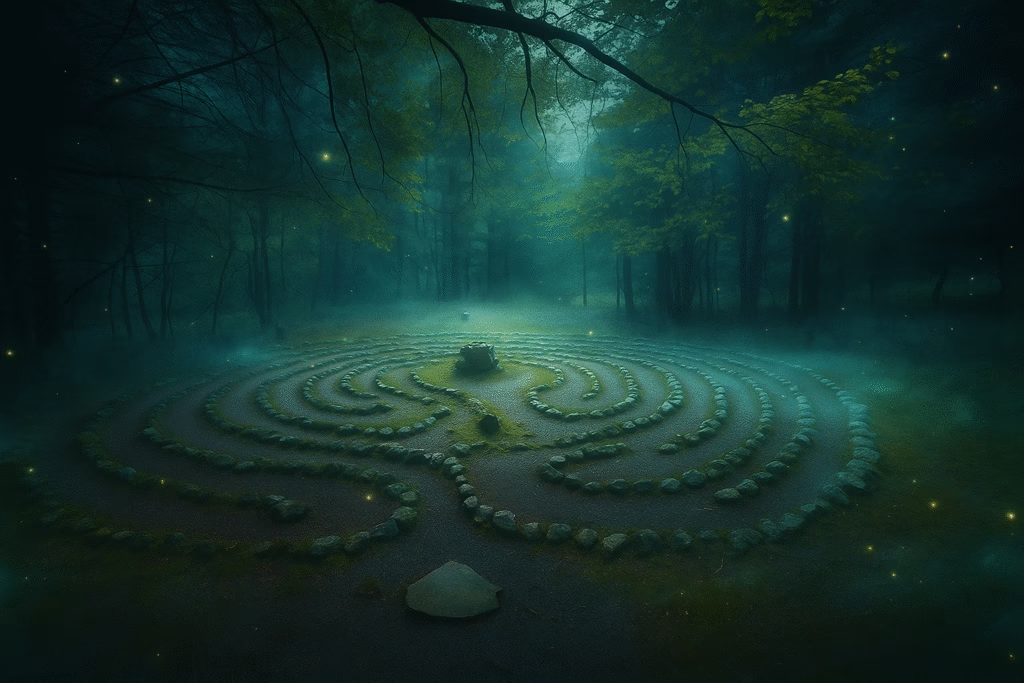
I’ve been to the real Stonehenge in England, and while Columcille Megalith Park in Bangor, Northampton County, might not have the same ancient pedigree, it’s got something that the original lacks – you can actually walk among the stones and experience them up close and personal.
This Celtic-inspired megalithic park in the Pocono Mountains foothills was created by William Cohea Jr. starting in 1975 as a place for meditation and spiritual reflection, and honestly? It works. There’s something about standing in the center of these stone circles, especially during sunrise or sunset, that just shifts your entire mindset. The 80-acre park features multiple stone circles, standing stones, and dolmens arranged according to Celtic traditions and astronomical alignments.
The park hosts seasonal celebrations like solstice ceremonies, Beltane festivals, and Samhain gatherings, and if you’re into that kind of thing, it’s pretty magical. Even if you’re not particularly spiritual, the craftsmanship and thought that went into creating these stone arrangements over nearly five decades is impressive as hell.
What I love about this place: It doesn’t try to be something it’s not. It’s not pretending to be ancient – it’s creating something meaningful for right now. The stones were carefully selected and placed to create a space for contemplation and connection with nature in the modern world.
For more information about visiting and upcoming events, check the Columcille Megalith Park website for current schedules and seasonal celebrations.
Lost Children of the Alleghenies Monument – A Tragic Tale
This one’s heavy, and I’m not gonna pretend otherwise. Deep in the Bedford County woods stands the Lost Children of the Alleghenies Monument, also known as the Pavia Monument, commemorating one of Pennsylvania’s most heartbreaking tragedies – the story of Joseph Cox (age 7) and George Cox (age 5), two young boys who got lost in these mountains on April 24, 1856, and were never found alive.
The hike to reach this granite monument, erected in 1906, is challenging and remote, which somehow makes the whole experience even more poignant. You’re walking through the same type of Allegheny Mountain wilderness where these kids spent their final days, and it really drives home how vast and unforgiving these mountains can be, even today.
What makes this story even more tragic is that it sparked one of the largest search efforts in Pennsylvania history at the time. Hundreds of volunteers from across Bedford County and neighboring areas combed these mountains for weeks, but the boys weren’t found until months later. The monument marks the spot where their remains were discovered, and it’s a sobering reminder of how quickly the wilderness can claim lives.
Why I include this: Because these places aren’t just about adventure and cool photos. They’re about real people, real stories, real consequences. The Cox family’s tragedy became part of Pennsylvania folklore, inspiring poems, songs, and stories that were passed down through generations. Respecting that history is part of exploring responsibly.
If you’re planning to visit remote areas like this, our budget travel guide includes essential safety tips for exploring off-the-beaten-path destinations safely and affordably.
Pennsylvania Historic Sites: Transportation Marvels
Thousand Steps Trail: Historic Pennsylvania Quarry Workers Path

Let me be straight with you – the Thousand Steps Trail on Jack’s Mountain in Huntingdon County is going to kick your ass. But in the best possible way. These 1,037 stone steps were built by quarry workers in the early 1900s who had to climb this mountain every single day to extract Tuscarora sandstone from the quarries at the summit, and hiking them today is both a serious workout and a history lesson that’ll make you appreciate how hard people used to work.
The 850-foot elevation gain might not sound like much when you’re sitting comfortably reading this, but when you’re actually climbing these uneven stone steps hand-laid over a century ago, your legs will definitely have opinions about your life choices. I’ve done this hike probably a dozen times over the years, and it never gets easier – but the views from the top never get old either.
| Thousand Steps Challenge | Details |
|---|---|
| Total Steps | 1,037 stone steps |
| Elevation Gain | 850 feet |
| Distance | 1.7 miles round trip |
| Difficulty | Strenuous |
| Best Time | Early morning or late afternoon |
| What to Bring | Water, good hiking boots, camera |
| Parking | Roadside parking on PA Route 26 |
At the summit, you’ll find the ruins of the old Tuscarora sandstone quarry operation that employed dozens of workers who made this climb twice daily. The panoramic views of the Juniata River Valley and surrounding Huntingdon County ridges are absolutely spectacular. On a clear day, you can see for miles in every direction. It’s one of those climbs where the journey teaches you as much as the destination rewards you.
Real talk: Take your time, bring plenty of water, and don’t be embarrassed if you need to stop and catch your breath. The quarry workers who built these steps were in incredible shape from doing this every day. You’re not, and that’s okay.
Pennsylvania Hidden Gems FAQ: Common Questions Answered
Best Times to Visit Pennsylvania Hidden Gems
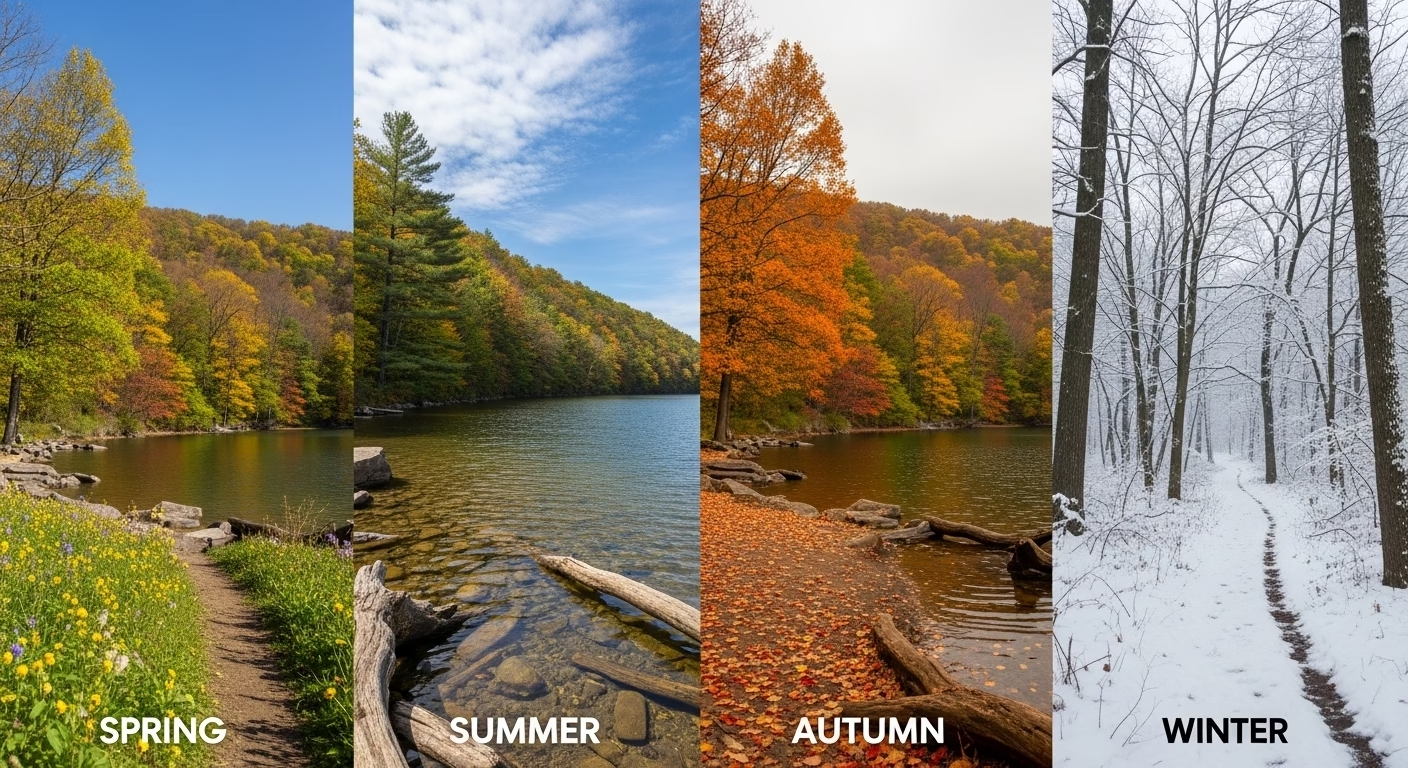
Here’s the thing about Pennsylvania’s hidden gems – timing is everything. I’ve learned this the hard way after showing up to places during the worst possible conditions and having to turn around disappointed.
Spring (April-May) is fantastic for wildflower photography, especially mountain laurel blooms in the Pocono Mountains, and comfortable hiking temperatures. However, some remote locations might still be muddy or have limited access due to spring runoff, and Seven Tubs can be too cold for swimming.
Summer (June-August) is obviously prime time for places like Seven Tubs where you can actually swim in the glacial potholes, and it’s when most trails are in their best condition. The trade-off is crowds at the more accessible locations and potentially hot, humid conditions for strenuous hikes like the Thousand Steps.
Fall (September-October) is absolutely magical for photography, especially at places like Hammersley Wild Area where the old-growth Eastern Hemlock forest contrasts beautifully with the surrounding hardwood fall colors. Weather can be unpredictable in Pennsylvania’s mountains, though, so layer up and be prepared for anything.
Winter (November-March) can be brutal for accessing remote locations, especially in Potter County where snow can make trails impassable. However, if you’re properly prepared, the abandoned places take on this haunting, almost post-apocalyptic beauty that’s impossible to capture any other time of year.
Pennsylvania Hidden Gems Safety Guide and Planning Tips
Look, I’m going to be real with you about something that a lot of travel bloggers gloss over – some of these places can be genuinely dangerous if you’re not prepared or if you make stupid decisions.
Abandoned structures are called abandoned for a reason. Floors can collapse, there can be hidden holes, rusty metal, asbestos, and all sorts of hazards that can ruin your day real quick. Always bring a first aid kit, tell someone exactly where you’re going and when you’ll be back, and don’t take unnecessary risks for the sake of a photo.
For the natural areas, weather can change rapidly in Pennsylvania’s mountains, especially in Potter County and the higher elevations. I’ve been caught in sudden thunderstorms that turned easy hikes into survival situations. Check the weather forecast, bring appropriate gear, and honestly know your limits.
Leave No Trace principles aren’t just suggestions – they’re essential for preserving these places for future explorers. Pack out everything you bring in, don’t disturb historical artifacts, and respect private property boundaries. These places are special because they’re not overrun yet. Let’s keep it that way.
For current trail conditions and safety updates, always check the Pennsylvania Department of Conservation and Natural Resources website before heading out.
Pennsylvania Hidden Gems Itinerary: Regional Clustering Guide
Regional Clustering for Efficient Exploration
| Western PA Cluster | Central PA Cluster | Eastern PA Cluster |
|---|---|---|
| Bilger’s Rocks (Clearfield County) | Austin Dam Ruins (Potter County) | Seven Tubs (Luzerne County) |
| Abandoned Turnpike (Bedford County) | Hammersley Wild Area (Potter County) | Columcille Megalith Park (Northampton County) |
| Thousand Steps (Huntingdon County) | Wehrum Ghost Town (Indiana County) | Lost Children Monument (Bedford County) |
| Best Base: State College area | Best Base: Coudersport/Potter County | Best Base: Scranton/Wilkes-Barre |
| Duration: 3-4 days | Duration: 4-5 days | Duration: 2-3 days |
The key to efficiently exploring Pennsylvania’s hidden gems is clustering your visits by region. Trying to hit all these locations in one trip is going to result in a lot of driving and not much actual exploring.
I recommend picking one cluster and really diving deep into that region. Spend 3-5 days in each area, allowing time to properly explore each location without rushing. Some of these places deserve a full day, especially if you’re into photography or just want to soak in the atmosphere and history.
Pro planning tip: Book accommodations in advance, especially during fall foliage season in Potter County and the Pocono Mountains. These areas don’t have a ton of lodging options, and the good places fill up fast.
Start Your Pennsylvania Hidden Gems Adventure
After two decades of travel blogging and exploring hidden corners of the world, I can honestly say that Pennsylvania’s secret places rank among the most surprising and rewarding destinations I’ve ever discovered. These aren’t just tourist attractions – they’re genuine adventures that require effort, respect, and a sense of curiosity about the stories that landscapes can tell.
The beauty of these hidden gems is that they’re not going anywhere. Unlike some travel destinations that are being loved to death by social media exposure, most of these places will still be here, still be relatively unknown, and still be ready to surprise you years from now.
So grab your hiking boots, charge your camera batteries, and prepare to see Pennsylvania in a completely different light. These hidden gems are waiting to share their secrets with anyone curious enough to seek them out. Just remember to tread lightly, explore responsibly, and leave these incredible places better than you found them.
The best adventures often happen when you step off the beaten path and into the unknown. Pennsylvania’s hidden gems are proof that you don’t need to travel to the other side of the world to find places that will absolutely blow your mind.
Ready to start exploring? Check out the official Pennsylvania tourism website for additional resources and current conditions, and don’t forget to share your own discoveries – responsibly, of course. The adventure is out there, waiting for you to find it.
For more travel inspiration and hidden gems across the United States, explore our collection of summer vacation destinations to plan your next adventure.



Pingback: New England Fall Road Trip Without the Crowds: A 2025 Local's Guide - atypicvoyage.com